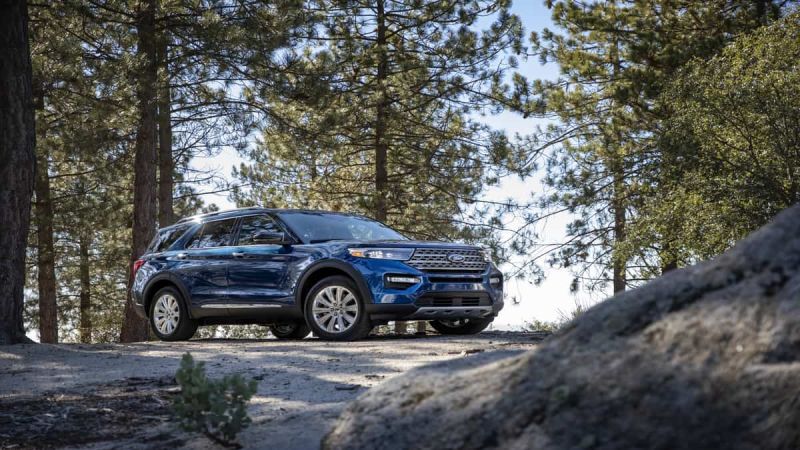Ford is promising that its all-new 2020 Ford Explorer is a complete redesign of America’s all-time best-selling sport utility vehicle. Because the all-new Explorer is supposed to set the bar for all of the other SUVs and crossovers that will be introduced in the new few years, it will be loaded with the latest technology that Ford has to offer.
New Technology to Make Driving Safer
For example, the 2020 Explorer will be available with a brilliant new feature designed to help those of us who have been known to speed. It is part of Ford’s all-new Intelligent Adaptive Cruise Control with Speed Sign Recognition. In addition to automatically slowing when traffic ahead of the vehicle slows down and helping keep the vehicle centered in its lane, the system uses cameras to read speed limit signs and adjusts the cruise control settings accordingly. This technology will really come into play in the future of self-driving vehicles, but for now, will save many of us from speeding tickets.
One of the foremost improvements is a new 10.1-inch touch screen for the driver. The screen will offer maps and new Ford Co-Pilot360 driver assist technology to help the driver in every situation.
The New Co-Pilot360 is a suite of safety technology. It includes Active Park Assist 2.0, which will handle everything involved with parking a vehicle with just the touch of a button. It handles steering, shifting, braking and the accelerator to totally park the vehicle.
Active Park Assist 2.0 will be standard on Explorer Platinum. It will allow the driver to park in a parallel or perpendicular spot with a touch of a button without having to work the steering wheel, gear shifter, gas pedal or brake pedal. Available reverse brake assist uses radar and ultrasonic sensors to detect an object in Explorer’s path, and can apply the brakes automatically to avoid an imminent collision when the vehicle is backing up at a low speed. That will come in very handy for anyone who ever has to back out of a driveway. (Which is just about everyone).
“Explorer drivers told us what they want – more capability, more power, more space,” said Hau Thai-Tang, Ford’s head of product development and purchasing. “They want more technology, not just for the driver, but for the whole family. And they want all of it with a beautifully sporty exterior. This new Explorer gives them all of that, and more, helping make every journey more enjoyable.”
Co-Pilot360 also senses all traffic around the Explorer and alerts drivers to traffic in any direction. Another new feature is Evasive Steering Assist, which provides steering support to help avoid a collision. Also, Ford will now offer Post-Impact Braking. This is designed to keep a crash from becoming even worse. It provides braking after a collision to lessen injury and damage caused by a secondary crash event.
Some of the other new Co-Pilot360 technology includes:
- Pre-Collision Assist with Automatic Emergency Braking, which includes Pedestrian Detection, Forward Collision Warning and Dynamic Brake Support
- Blind Spot Information System with Cross-Traffic Alert
- Lane-Keeping System
- Rearview camera with built-in lens cleaner
- Auto headlamps with auto high-beams
“It’s not about filling the vehicle with technology for technology’s sake,” said Chris Billman, Ford Co-Pilot360 engineering manager. “It’s about improving the experience, making driving less stressful, and helping the driver to feel more confident behind the wheel.”
New Technology to Improve Connectivity
Passengers in all three rows will now have access to FordPass Connect. This will give up to ten mobile devices 4G LTE Wi-Fi. FordPass Connect gives drivers remote access to their Explorer, allowing them to use their smartphone to lock, unlock, locate and start the vehicle, as well as monitor key vehicle diagnostics. The updated SYNC 3 system has a more intuitive layout. It gives drivers compatibility with available features such as Apple CarPlay®, Android Auto® and Waze navigation. Ford understands that connectivity is important to everyone in the vehicle. A wireless charging pad is available that allows customers to recharge compatible mobile devices, and up to four USB ports, including new type-C outlets, charge next-generation mobile devices. Up to three 12-volt outlets and a 110-volt outlet are also available.
“We obsessed about what Explorer customers need and want,” said Bill Gubing, Explorer chief engineer. “We met with customer groups, pored through internet forums, and dissected social media posts to determine what they love about today’s Explorer and understand their pain points. Then we found ways to improve it across the board. Every enhancement on this all-new Explorer was inspired by our customers.”
New Technology to Improve Handling
Better technology also allows Ford to offer a new Terrain Management System. This gives the driver the ability to select different drive modes depending on the situation. A dial in the center displays the options like normal, trail, deep snow, towing, slippery, sport and eco. Each different mode comes with special animated graphics.
The 2020 Explorer also comes standard with the power liftgate. Platinum models also have a twin-panel moonroof, which will bring more of the great outdoors inside the vehicle.
Torque News Managing Editor Patrick Rall has more on the powertrain improvements to the all-new 2020 Ford Explorer here.













Comments
The cameras in adaptive speed
Permalink
The cameras in adaptive speed control also mistakenly read county road signs (also white with black border and numbers) in Minnesota as speed limit signs. This happened to us twice in 60 mile or so stretch of road. Once accelerating up to 70+ miles per hour when approaching a road sign for county road 70, and once slowing while approaching a sign for county road 35. In both cases, adaptive speed control set at 67 mph. I could see how this could potentially be dangerous—unexpected slowdowns in traffic, for example, or a driver startled by and unexpected acceleration. What about county road 80? What is the range of speed the intelligence system reads? Would it attempt to accelerate to a max of 9 miles above the “speed limit”? We were traveling in a rural area with very light traffic, so for us a moot point. However, I can see how this feature could be hazardous.